Fast radio bursts, or FRBs, have transfixed astronomers for over a decade, but their origin remains unclear. A newly concluded survey identifies an unexpected and unusually long 157-day cycle for a known repeating FRB, in a discovery that’s redefining what we know about these mysterious intergalactic pulses.
Something — we don’t know what — is shooting short, high-energy radio pulses into the depths of space, and it’s doing so in a regular pattern, according to new research published in Monthly Notices of the Royal Astronomical Society.
The source of these bursts, designated FRB 121102, is located in a dwarf galaxy some 3 billion light-years from Earth. The newly detected pattern lasts for 157 days, in which FRB 121102 is active for 90 days, then completely silent for 67 days. Lather, rinse, and repeat.
This pattern was detected by astronomers at the University of Manchester, who used the Lovell Telescope to monitor the FRB for the past four years. This survey captured 32 distinct bursts, which, when combined with previous data collected for the FRB, revealed the pattern. FRB 121102 is the first of only two known repeating FRBs, the other being FRB 180916.J10158+56, but the 157-day pattern was not known until now. The new research was led by astrophysicist Kaustubh Rajwade from the University of Manchester.
First discovered in 2007, FRBs were once thought to be caused by one-time events, such as exploding stars, but the discovery of repeating FRBs has forced a re-think. Current theories include rapidly spinning neutron stars with strong magnetic fields (known as magnetars), mergers of super-dense objects, supermassive black holes, and even the activities of extraterrestrial civilizations.
Importantly, FRB 180916.J10158+56 also follows a distinct pattern, as Canadian scientists revealed last year. This particular FRB is active for four days and then quiet for 12 days, in a cycle lasting for 16 days, which is roughly 10 times shorter than the period observed for FRB 121102. That’s a potent new clue for astronomers trying to pinpoint the source of these strange celestial emissions.
Harvard University astronomer Avi Loeb, who wasn’t involved in the new research, said the “most natural explanation” for this 157-day cycle would involve a source object, such as a young neutron star, in orbit around a companion object, in a configuration that shoots radioactive bursts in our general direction for a fraction of its orbit. Another possibility, he said, is that the companion is not a neutron star but a normal star or some sort of stellar remnant weighing roughly as much as our own Sun.
“An orbital period of 0.43 years would correspond to an orbital separation [the distance between two bodies] of about half of the Earth-Sun separation,” Loeb told Gizmodo. “If the source emits a pair of beams in opposite directions, it is possible that 157 days is only half of the orbital period — in which case the orbital radius is similar to that of the Earth around the Sun.”
One possibility that’s possibly ruled out by the new research is a wobbling magnetar, as noted in a University of Manchester press release:
Repeating FRBs could be explained by the precession, like a wobbling top, of the magnetic axis of a highly magnetized neutron star but with current data scientists believe it may be hard to explain a 157-day precession period given the large magnetic fields expected in these stars.
It’s also possible that FRB 121102 and FRB 180916.J10158+56, though repeaters with fixed periods, are generated by two different types of celestial phenomena. Clearly, we still have lots to learn about these bursts. And as Loeb told Gizmodo, “additional data is needed to firm up the statistical periodicity inferred” for both of these FRBs.
[referenced url=”https://gizmodo.com.au/2020/05/intergalactic-pulses-solve-mystery-of-universes-missing-matter/” thumb=”https://gizmodo.com.au/wp-content/uploads/2020/05/29/rgokjjqb9vrb3lvbufml-300×169.jpg” title=”Intergalactic Pulses Solve Mystery of Universe’s Missing Matter” excerpt=”Scientists have spent three decades trying to locate half of all the “normal” matter that’s supposed to exist in the universe. A new paper is claiming to have finally found this missing stuff, in a discovery made possible by measuring incoming fast radio bursts.”]
We may not understand these FRBs, but they’re very much real. So real, in fact, that FRBs are being used to solve long-standing scientific mysteries, such as the location of missing matter in the universe, as revealed in a recent study.
